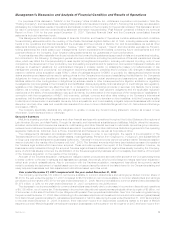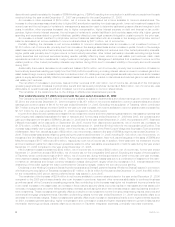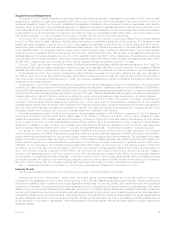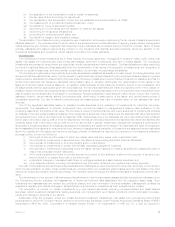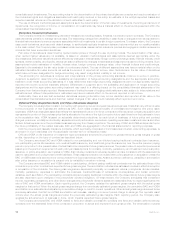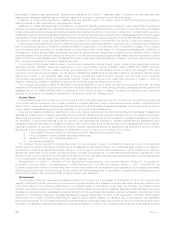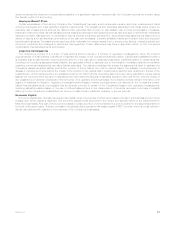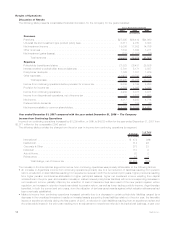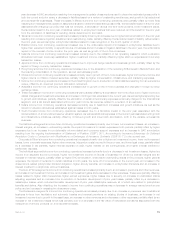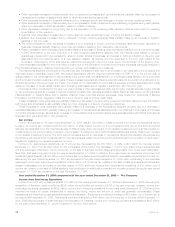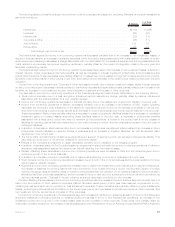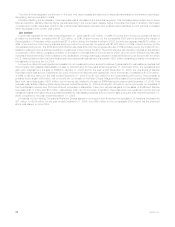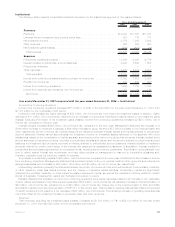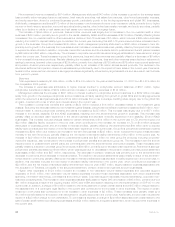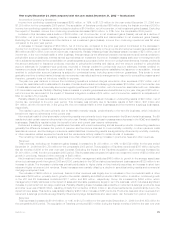MetLife 2007 Annual Report Download - page 19
Download and view the complete annual report
Please find page 19 of the 2007 MetLife annual report below. You can navigate through the pages in the report by either clicking on the pages listed below, or by using the keyword search tool below to find specific information within the annual report.year decrease in DAC amortization resulting from management’s update of assumptions used to determine estimated gross profits in
both the current and prior years, a decrease in liabilities based on a review of outstanding remittances, and growth in its institutional
and universal life businesses. These increases in Mexico’s income from continuing operations were partially offset by lower fees
resulting from management’s update of assumptions used to determine estimated gross profits, the favorable impact in the prior year
associated with a large group policy that was not renewed, a decrease in various one-time revenue items, lower investment yields,
the favorable impact in the prior year of liabilities related to employment matters that were reduced, and the benefit in the prior year
from the elimination of liabilities for pending claims determined to be invalid.
• Taiwan’s income from continuing operations increased primarily driven by an increase due to higher DAC amortization in the prior year
resulting from a loss recognition adjustment and restructuring costs, partially offset by the favorable impact of liability refinements in
the prior year, as well as higher policyholder liabilities related to loss recognition in the fourth quarter of 2006.
• Brazil’s income from continuing operations increased due to the unfavorable impact of increases in policyholder liabilities due to
higher than expected mortality on specific blocks of business and an increase in litigation liabilities in the prior year, the unfavorable
impact of the reversal of a tax credit in the prior year, as well as growth of the in-force business.
• Ireland’s income from continuing operations increased primarily due to the utilization of net operating losses for which a valuation
allowance had been previously established, higher investment income, partially offset by higher start-up expenses and currency
transaction losses.
• Japan’s income from continuing operations increased due to improved hedge results and business growth, partially offset by the
impact of foreign currency transaction losses.
• Hong Kong’s income from continuing operations increased due to the acquisition of the remaining 50% interest in MetLife Fubon and
the resulting consolidation of the operation, as well as business growth.
• Chile’s income from continuing operations increased primarily due to growth of the in-force business, higher joint venture income and
higher returns on inflation indexed securities, partially offset by higher compensation, infrastructure and marketing expenses.
• Income from continuing operations increased in the United Kingdom due to a reduction of claim liabilities resulting from an experience
review, offset by an unearned premium calculation refinement.
• Australia’s income from continuing operations increased due to growth of the in-force business and changes in foreign currency
exchange rates.
• These increases in income from continuing operations were partially offset by a decrease in the home office due to higher economic
capital charges and investment expenses, an increase in contingent tax expenses in the current year, as well as higher spending due
to growth and initiatives, partially offset by the elimination of certain intercompany expenses previously charged to the International
segment, and a tax benefit associated with a prior year income tax expense related to a revision of an estimate.
• India’s income from continuing operations decreased primarily due to headcount increases and growth initiatives, as well as the
impact of valuation allowances established against losses in both years.
• South Korea’s income from continuing operations decreased due to a favorable impact in the prior year associated with the
implementation of a more refined reserve valuation system, as well as additional expenses in the current year associated with growth
and infrastructure initiatives, partially offset by continued growth and lower DAC amortization, both in the variable universal life
business.
The Institutional segment’s income from continuing operations increased primarily due to lower net investment losses, an increase in
interest margins, an increase in underwriting results, the impact of revisions to certain expenses in both periods, partially offset by higher
expenses due to an increase in non-deferrable volume-related and corporate support expenses and an increase in DAC amortization
resulting from the ongoing implementation of Statement of Position (“SOP”) 05-1, Accounting by Insurance Enterprises for Deferred
Acquisition Costs in Connection with Modifications or Exchanges of Insurance Contracts (“SOP 05-1”) in the current year.
Corporate & Other’s income from continuing operations increased primarily due to higher net investment income, lower net investment
losses, lower corporate expenses, higher other revenues, integration costs incurred in the prior year, and lower legal costs, partially offset
by a decrease in tax benefits, higher interest expense on debt, higher interest on tax contingencies, and higher interest credited to
bankholder deposits.
The Individual segment’s income from continuing operations increased primarily due to a decrease in net investment losses, higher fee
income from separate account products, higher net investment income on blocks of business not driven by interest margins and an
increase in interest margins, partially offset by higher DAC amortization, unfavorable underwriting results in life products, higher general
expenses, the impact of revisions to certain liabilities in both years, the write-off of a receivable in the current year, an increase in the
closed block-related policyholder dividend obligation, higher annuity benefits, an increase in policyholder dividends and an increase in
interest credited to policyholder account balances.
The Auto & Home segment’s income from continuing operations increased primarily due to an increase in premiums and other revenues,
an increase in net investment income, an increase in net investment gains and a decrease in other expenses. These were partially offset by
losses related to higher claim frequencies, higher earned exposures, higher losses due to severity, an increase in unallocated claims
adjusting expenses and an increase from a reduction in favorable development of prior year losses, partially offset by a decrease in
catastrophe losses, which included favorable development of prior year catastrophe reserves, all of which are related to policyholder
benefits and claims. Also offsetting the increase in income from continuing operations was a decrease in average earned premium per
policy and an increase in catastrophe reinsurance costs.
The Reinsurance segment’s income from continuing operations increased primarily due to an increase in premiums due to additional
business in-force from facultative and automatic treaties and renewal premiums on existing blocks of business, an increase in net
investment income due to growth in the asset base, an increase in other revenues and a decrease in other expenses, partially offset by an
increase in net investment losses which was primarily due to a decrease in the fair value of embedded derivatives associated with the
reinsurance of annuity products on a funds withheld basis.
15MetLife, Inc.


